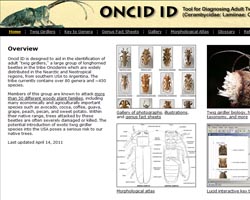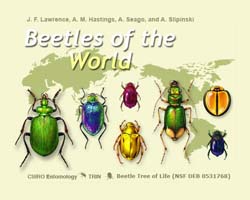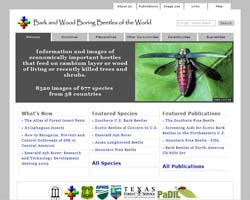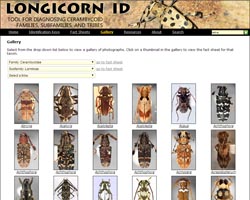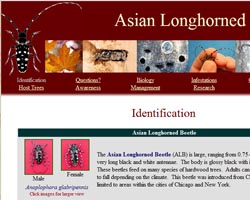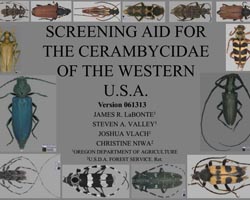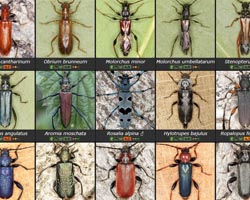Wood Boring Beetle Resource
Family Tool Search
Use the select menu to the left to view tools for a specific family or all families of wood boring beetles.
Oncid ID: Tool for Diagnosing Adult Twig Girdlers (Cerambycidae: Lamiinae: Onciderini)
- Oncid ID is designed to aid in the identification of adult 'twig girdlers,' a large group of longhorned beetles which occurs from North America to Argentina. Members of this group are known to attack 57 different woody plant families, including many economically and agriculturally important species such as avocado, cocoa, coffee, guava, grape, peach, and pecan. Within their native range, trees attacked by these beetles are often severely damaged or killed. The potential introduction of exotic twig girdler species into the USA poses a serious risk to our native trees.
- Taxonomic scope: Cerambycidae
- Geographic scope: Nearctic, Neotropic
- Authors: Nearns, E.H., N.P. Lord, and K.B. Miller
- Release date: 2011
Beetles of the World
- Beetles (order Coleoptera) are the most diverse and species-rich group of animals in the world. This fully-illustrated key allows users to identify adult beetles to the level of family, subfamily, and often to genus.
- Taxonomic scope: Anobiidae, Bostrichidae, Brentidae, Buprestidae, Cerambycidae, Curculionidae, Lymexilidae, Oedemeridae, Zopheridae
- Geographic scope: World
- Authors: Lawrence, J.F., A.M. Hastings, A. Seago, and A. Slipinski
- Release date: 2010
Wood Boring Beetle Families of the World
- Wood Boring Beetle Families delimits family-level taxa (both adults and larvae) of Coleoptera known to be wood borer.
- Taxonomic scope: Anobiidae, Bostrichidae, Brentidae, Buprestidae, Cerambycidae, Curculionidae, Lymexilidae, Oedemeridae, Zopheridae
- Geographic scope: World
- Authors: Cline, A.R., M.A. Ivie, C.L. Bellamy, and J. Scher
- Release date: 2009
Bark and Wood Boring Beetles of the World
- Information and images of economically important beetles that feed on cambium layer or wood of living or recently killed trees and shrubs, featuring 8320 images of 677 species from 38 countries.
- Taxonomic scope: Buprestidae, Cerambycidae, Curculionidae
- Geographic scope: World
- Authors: Anonymous
- Release date: 2008
Longhorn Beetles (Cerambycidae) of the West Palearctic Region
- Regularly updated photo-gallery containing over 650 West Palaearctic taxa. This website contains details on biology of selected species, information on host plants of several species, and various expedition reports.
- Taxonomic scope: Cerambycidae
- Geographic scope: Palearctic
- Authors: Hoskovec, M. and M. Rejzek
- Release date: 1997
Cerambycidae Holotypes of the Museu de Zoologia Universidade de São Paulo
- The MZSP currently has over 900 primary types for Cerambycidae. Authors of these types include Bruch, Dias, Fonseca-Gessner, Galileo, Gounelle, Hovore, Lane, Linsley, Martins, Melzer, Mendes, Monné, Napp, Santos-Silva, Tavakilian, Zajciw, Zikán, and others. The types are predominantly of the Neotropical fauna. We have set up the search page to allow users to find images of types by tribe, by country, by author, by original name, or by current name if different.
- Taxonomic scope: Cerambycidae
- Geographic scope: Neotropic
- Authors: Martins, U.R., M.A. Monné, M.L. Monné, S.W. Lingafelter, C.J. Micheli, and E.H. Nearns
- Release date: 2006
Cerambycidae Holotypes of the Museu Nacional Rio de Janeiro
- The MNRJ currently has nearly 1,000 primary types for Cerambycidae. Authors of these types include Bosq, Delfino, Fragoso, Galileo, Giorgi, Huedepohl, Julio, Lane, Magno, Marinoni, Martins, Mermudes, M.A. Monné, M.L. Monné, Napp, Santos-Silva, Tavakilian, Tippmann, Zajciw, and many others. The types are predominantly of the Neotropical fauna. We have set up the search page to allow users to find images of types by tribe, by country, by author, by original name, or by current name if different.
- Taxonomic scope: Cerambycidae
- Geographic scope: Neotropic
- Authors: Monné, M.A., M.L. Monné, S.W. Lingafelter, C.J. Micheli, and E.H. Nearns
- Release date: 2006
Cerambycidae of Florida
- This photographic atlas of the Cerambycidae of Florida grew directly out of efforts at the Florida State Collection of Arthropods in the past few decades to document the arthropod fauna of the state, and especially out of the Florida beetle checklist by Stewart Peck and the senior author.
- Taxonomic scope: Cerambycidae
- Geographic scope: Nearctic
- Authors: Thomas, M.C., S. Hill, R.F. Morris, E.H. Nearns
- Release date: 2005
A Photographic catalog of the Cerambycidae of the World
- The purpose of this photographic catalog of the Cerambycidae of the New World is to provide images that will assist in the identification of longhorn beetles. Many species of longhorn beetles are invasive and authoritative identifications are necessary to initiate regulatory actions. It is hoped that the images in this catalog will in part provide information to identifiers to make their jobs easier. Familiarity with the New World fauna is critical to understanding the distribution of invasive species. Cerambycid workers are fortunate that in many instances a dorsal image of these beetles is distinctive.
- Taxonomic scope: Cerambycidae
- Geographic scope: World
- Authors: Bezark, L.G.
- Release date: 2005
Cerambycoid Primary Types of the Smithsonian Institution
- The Smithsonian Institution currently has over 2,100 primary types for Cerambycoidea (families Cerambycidae, Disteniidae, Oxypeltidae, and Vesperidae). Authors of these types include Aurivillius, Breuning, Casey, Chemsak, Dillon & Dillon, Fisher, Galileo, Gressitt, Kriesche, Lane, Linell, Lingafelter, Linsley, Martins, Melzer, Micheli, Monné, Nearns, Schaeffer, Schwarzer, Tippmann, and many others. The types represent fauna from over 30 countries from Afghanistan to Zaire, literally from A to Z, although emphasis is on the United States, the Caribbean, and Central and South America. We have set up the search page to allow users to find images of types by tribe, by country, by author, by original name, or by current name if different.
- Taxonomic scope: Cerambycidae
- Geographic scope: World
- Authors: Lingafelter, S.W., M.A. Monné, and E.H. Nearns
- Release date: 2014
Longicorn ID: Tool for Diagnosing Cerambycoid Families, Subfamilies, and Tribes
- Cerambycoid beetles include the large family Cerambycidae and three smaller families: Disteniidae, Oxypeltidae, and Vesperidae. Together, these families are a charismatic and economically important group of beetles with an estimated 4,000 genera and 35,000 described species worldwide. Longicorn ID provides identification support to the four families, 14 subfamilies, and 250 tribes. Hundreds of specimen photographs are available, including dozens of holotype specimens, making this tool particularly valuable for accurate identification. The most recent update (2017) adds a Lucid key and fact sheets to the larvae at the family and subfamily level.
- Taxonomic scope: Cerambycidae
- Geographic scope: World
- Authors: Nearns, E.H., Lord, N.P., Lingafelter, S.W., Santos-Silva, A., Miller, K.B., and J.M. Zaspel
- Release date: 2017
Asian Longhorned Beetle
- The Asian longhorned beetle (ALB) is an exotic pest threatening a wide variety of hardwood trees in North America. Adults are large (0.75 - 1.50 inches long) with very long black and white banded antennae. The body is glossy black with irregular white spots. The beetle was introduced into New York City, Chicago and New Jersey, and is a serious pest of hardwood trees. Adults can be seen from late spring to fall depending on the climate. Learn more about it's biology, how to distinguish ALB from other native insects, and what trees it infests.
- Taxonomic scope: Cerambycidae
- Geographic scope: Nearctic, Neotropic
- Authors: University of Vermont Entomology Research Lab
- Release date: 2011
Wood Boring Beetles
- Besides bark beetles, two other common families of beetles use woody plants to rear their offspring. The Buprestidae have one common name for the adult - metallic wood borer - and a second for the larvae - flat-headed wood borers. Similarly, adult Cerambycidae are generally known as long-horned beetles, while larvae are called round-headed wood borers. Some species in both families prefer conifers as hosts while others use only broadleaf trees. Many species attack live but usually stressed trees, while others prefer recently dead hosts.
- Taxonomic scope: Buprestidae, Cerambycidae
- Geographic scope: Neotropic
- Authors: Sutherland, Carol A.
- Release date: 2006
Screening Aid for the Cerambycidae of the Western U.S.A.
- This screening aid is not a comprehensive treatment of western North American Cerambycidae (roundheaded or longhorned wood borers). It is designed to enable efficient sorting and identification of the most abundant species found in wood boring insect trap samples from surveys conducted by the ODA and the USDA FS in the Pacific Northwest and the West over the past ten years. Several exotic pest species are also included. *This aid will be most reliable in the conifer forest regions west of the Rocky Mountains. It may not function well with species found in the desert West and east of the Rockies.
- Taxonomic scope: Cerambycidae
- Geographic scope: Nearctic
- Authors: LaBonte, J.R., Valley, S.A., Vlach, J., Niwa, C.
- Release date: 2013
Cerambycidae: The beetle fauna of Germany
- The longhorn beetles (Cerambycidae) are amongst the most "popular" beetle families and hence lots of research has been carried out on the family. The small to very large beetles are distributed worldwide (approx. 27,000 species). From Germany 195 species have been recorded. The beetles are characterized by their oblong body shape and their long antennae (family name!). The species feed on pollen or sap oozing from trees. The larvae develop on wood or herbaceous plants. Several are serious pests, with the larvae boring into wood, where they can cause extensive damage to either living trees or untreated lumber.
- Taxonomic scope: Cerambycidae
- Geographic scope: Palearctic
- Authors: Benisch, C.
- Release date: 2007
